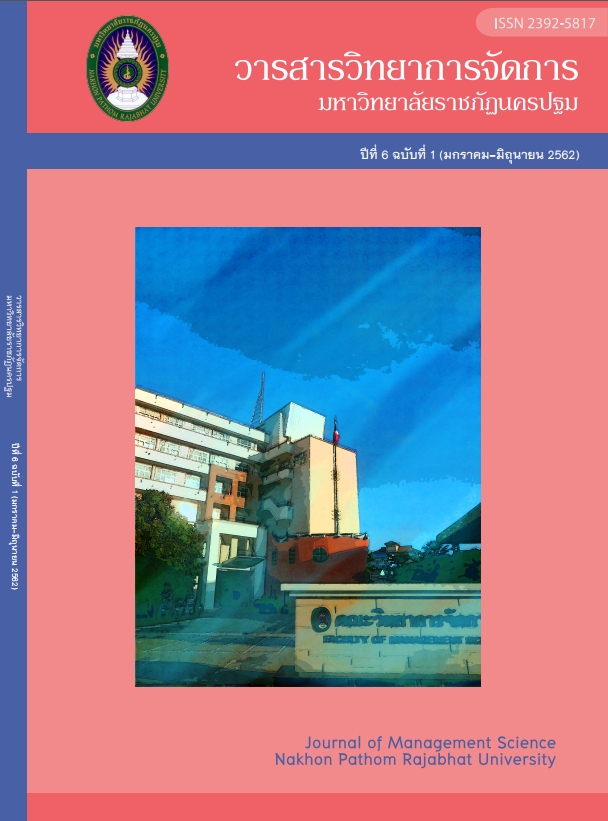Credit Scoring System and Quality of Auto Loan: The First Car Tax Rebate Policy Evaluation.
Main Article Content
Abstract
The purposes of this research intended to study The objective of this research is to study: 1. The efficiency of the credit scoring system in helping to filter out the auto loans that are likely to be bad debts or the auto loans without quality. 2. The efficiency of the debt history data obtained from the NCB examination in helping to filter out the auto loans that are likely to be bad debts or the auto loans without quality. 3. The factors affecting the quality of the auto loans especially and 4. the factor of take the rights of the auto loans group before and after the government issued the first car tax return policy.
Research Methodology is quantitative research. Secondary data is a panel of auto loan of a commercial bank of 6,288 contracts or 436,930 installments monthly. Using the Random Effected Ordered Probit Model to estimate variables.
The results indicate that 1. The credit scoring system consisting of guarantor variables, loan amount, down payment and the amount of installments according to the contract the auto loans with a high credit scoring will be less likely to be a bad debt than the auto loans with a low credit scoring. 2. The information on the debt payment history obtained from the NCB examination the auto loans with NCB score C, B and Q will have a better chance of bad debts than the auto loans with NCB score A. Thus the efficiency of the credit scoring system and the historical payment information obtained from the NCB examination can help screen the quality of the auto loans. 3. The factors affecting the quality of the auto loans contain with types of the auto loans and the amount of installments remaining by used car there is a chance of bad debt rather than new car due to the condition of used cars low down payment resulting in higher debt-to-value ratio and the auto loans with a high proportion of outstanding debt per car value will have a higher chance of bad debts than the auto loans debtors with the ratio of outstanding debt to the low car value. 4. The factors for take the right to the auto loans before and after the government issued the first car tax return policy. The auto loans that have the right to taking will have more chances of bad debts than the auto loans without take the right and will have taking the right the auto loans has increased during the first car tax return policy.
Article history : Received 25 December 2018
Revised 1 March 2019
Accepted 4 March 2019
SIMILARITY INDEX = 2.31
Article Details
The views and opinions of the article appearing in this journal are those of the author. It is not considered a view and responsibility of the editorial staff.
References
ธนาคารแห่งประเทศไทย. (2561). ยอดคงค้าง Gross NPLs ทั้งระบบจำแนกตามประเภทธุรกิจ. [ออนไลน์] ค้นเมื่อ 25 มกราคม 2561 ,จาก https://www.bot.or.th/Thai/Statistics/FinancialInstitutions/Pages/default.aspx, 25.
Altman, E. I. (1968). Financial Ratio, Discriminant Analysis and Prediction of Corporate Bankruptcy. The Journal of Finance. 23. 589-609.
Avery, R. B. (1981). Credit Scoring Models with Discriminant Analysis and Truncated Samples. Board of Governors of the Federal Reserve, Research Paper in Banking and Financial Economics No. 54. Washington, DC : Board of Governors of the Federal Reserve System.
De Lucia, R.D. & Peters, J. (1993). Five-C (5’C). (2nd ed). New York : Harper & Row Publishers.
Durand, D. (1941). Risk Elements in Consumer Instalment Financing. National Bureau of Economic Research, Retrieved May 25, 2017 from https://www.nber.org/books/dura41-2.
Einav, L., Jenkins M. & Levin J. (2013). The impact of credit scoring on consumer lending. RAND Journal of Economics. 44 (2). 249–274.
Greene, W. H. & Hensher, D. A. (2010). Modeling Ordered Choices: A Primer. Cambridge University Press.
Mester, L. J. (1997). What’s the Point of Credit Scoring?. Federal Reserve Bank of Philadelphia, September/October., 3-16
Mishkin, S. F. (2001). The Economics of Money Banking and Financial Markets. (6th ed.).Boston : Addison Wesley Longman.
Sjovoll, E. (1999). Assessment of Credit Risk in the Norwegian Business Sector. Norges Bank, August.
Stiglitz, J.E. & Weiss, A. (1981). Credit Rationing in Markets with Imperfect Information. The American Economic Review. 71 (3). 393-410.

